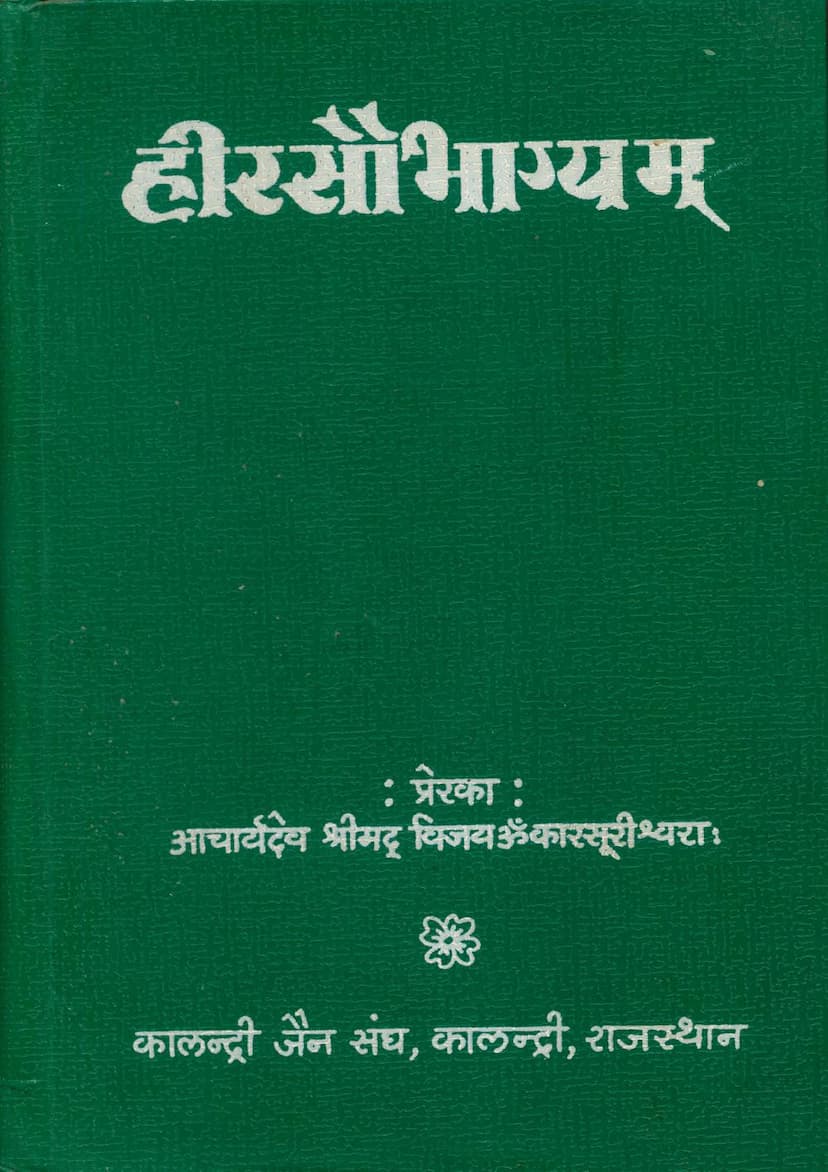Heer Saubhagya Mahakavyam
Added to library: September 1, 2025

Summary
Here's a comprehensive summary of the Jain text "Heer Saubhagya Mahakavyam" based on the provided pages:
Title: Heer Saubhagya Mahakavyam (The Auspicious Fortune of Hira)
Author: Devvimal Gani (with auto-commentary)
Editors: Pt. Shivdatta, Pt. Kashinath Sharma
Publisher: Kalandri Jain S M Sangh, Kalandri, Rajasthan
Catalouge Link: https://jainqq.org/explore/002262/1
Inspiration/Dedication: The publication of this Mahakavya is in the sacred memory of the Pratishtha (consecration) ceremony of Jinabimba idols of Lord Munisuvratnath Bhagwan and other Jinabimbas, which took place in Kalandri (Rajasthan) under the divine guidance of the esteemed Acharya Dev Shrimad Vijay Omkarsurishwarji Maharaj in V.S. 2040 (1983 AD).
Overview: Heer Saubhagya Mahakavyam is a grand epic poem (Mahakavya) composed in Sanskrit, detailing the life and glorious deeds of Jagadguru Shrimad Hiravijayasuriji Maharaj, a renowned Jain scholar-poet and a prominent figure in the 16th century AD. The work is highly acclaimed for its scholarly depth, poetic brilliance, and the intricate philosophical and linguistic insights provided by the author's own commentary.
Key Features and Content:
- Biographical Epic: The Mahakavya primarily focuses on the life of Hiravijayasuriji Maharaj, highlighting his birth, education, spiritual journey, association with Emperor Akbar, and his role as a spiritual leader.
- Poetic Excellence: The poem is praised for its captivating poetic talent, spread across seventeen cantos (Sargas) and containing approximately 3,768 verses (श्लोक). The author, Devvimal Gani, is lauded for his ability to create a "sea of rasa" (aesthetic emotion) through his verses.
- Comprehensive Commentary (Svopajña Vritti): Devvimal Gani's auto-commentary, referred to as "Sukhavabodha," is described as a vast reference text. It elaborates on the poem's verses, providing detailed explanations, citing numerous examples from other valid poetic works, and demonstrating the author's extensive knowledge (bahushrutva) and meticulous attention to detail in his composition. The commentary often draws from classical Sanskrit literature, grammar, and philosophy.
- Linguistic and Cultural Insights: The commentary offers valuable linguistic insights, referencing Sanskrit grammar texts like "Kriyākālap" and "Prakriyā Kaumudi" to validate word usage. It also incorporates contemporary Gujarati proverbs and sayings (lokokti/subhashita) within the explanations, shedding light on the cultural and linguistic context of the time. These insights also offer a glimpse into the evolution of language and linguistic analysis within Jain tradition.
- Historical Significance: The poem serves as a historical record, detailing interactions between Hiravijayasuriji and Emperor Akbar, who conferred upon him the title of "Jagadguru" (Teacher of the World). The Ain-i-Akbari and Akbarnama are mentioned as historical testimonies to their relationship.
- Hero's Biography: Hiravijayasuri (born Hiraji in V.S. 1583 in Palanpur) was initiated at the age of 13, became a Pandit at Nadlai, an Upadhyaya at Sirohi, and an Acharya at Nadlai. He became the Gacchanayaka (leader of the Tapagaccha) after the demise of his guru, Danasuri Maharaj. His significant journey to Akbar's court in V.S. 1639 (1582 AD) and the subsequent influence on the Emperor regarding Jain principles are key highlights.
- Structure and Content of the Mahakavya:
- Seventeen Cantos: The poem is divided into 17 cantos.
- Mangalacharan (Invocation): The epic begins with an auspicious invocation praising Lord Parshvanatha.
- Descriptions: The poem includes vivid descriptions of Gujarat, its rivers, towns (like Prahladanapura and Fatehpur Sikri), seasons, holy places (especially Satrunjaya Hill), and cultural practices.
- Narrative: It recounts the hero's life, from his birth and childhood, his renunciation, his studies, his interactions with royalty, his philosophical debates, and his ultimate spiritual attainment.
- Classical Mahakavya Characteristics: The work aims to fulfill the traditional characteristics of a Mahakavya, including detailed descriptions of nature, cities, personages, and significant events.
- Author's Background: Devvimal Gani was a disciple of Sinh-Vimal Gani. He is known for his erudite scholarship in both Jain and Brahmanical literature. He also composed the "Hirasundar Kavya," which is believed to have been later revised and expanded into "Hira Saubhagya Mahakavyam."
- Scholarly Value: The text is considered crucial for studying Sanskrit grammar, philology, and the history of Jain scholarship. The author's extensive quotations from various Sastric works underscore his profound knowledge.
- Errata (Shuddhi Patra): The publication includes an errata list to correct any printing mistakes in the text, indicating a commitment to accuracy.
Overall: Heer Saubhagya Mahakavyam is a significant literary and religious work in Jain tradition. It not only chronicles the life of a pivotal Jain Acharya but also serves as a rich repository of Sanskrit literature, grammar, philosophy, and historical accounts, illuminated by the author's profound commentary. The Kalandri Jain Sangh's effort in publishing this text is commendable, making this valuable work accessible to scholars and seekers of knowledge.